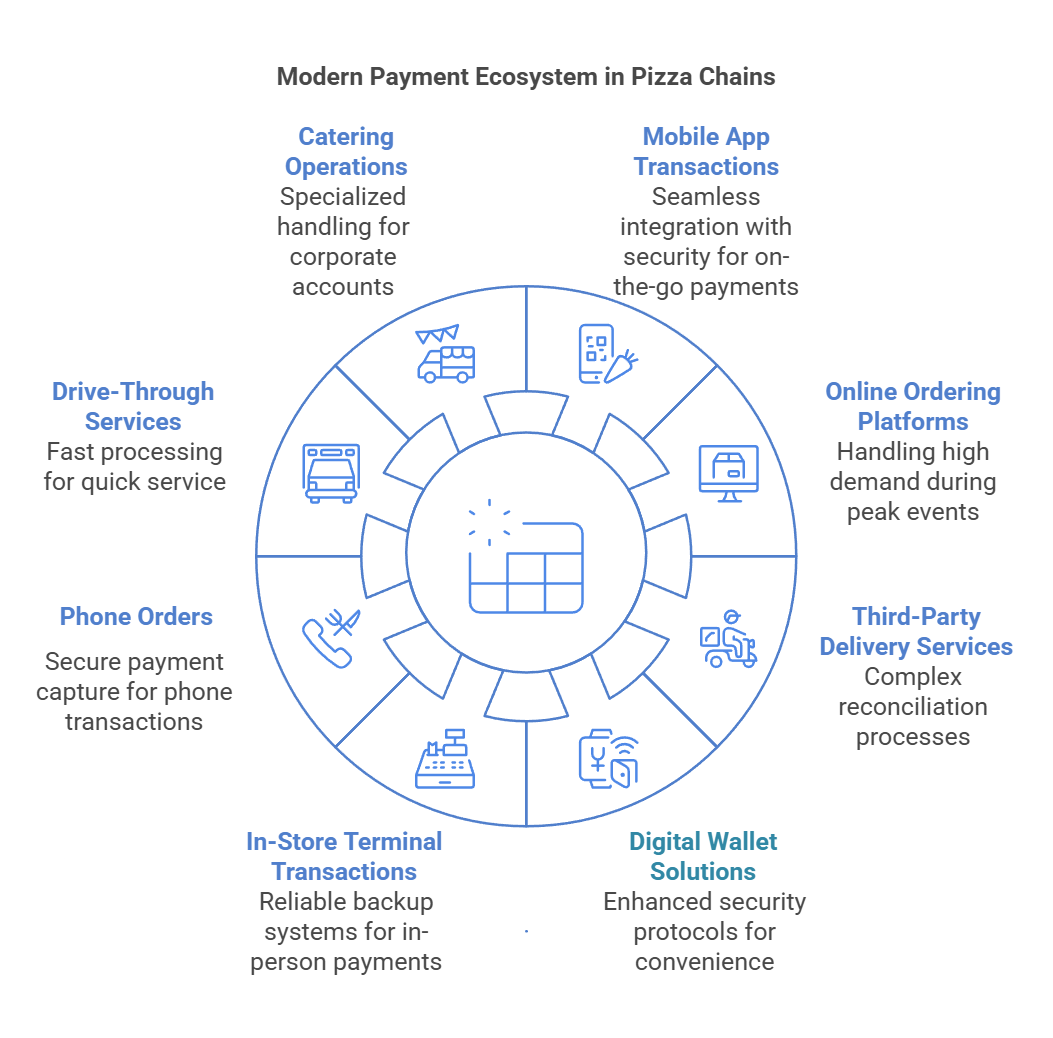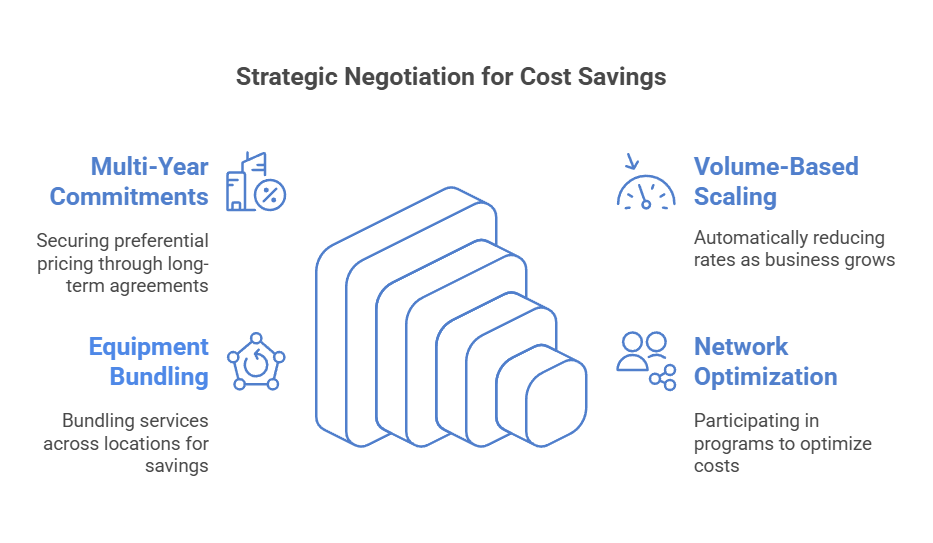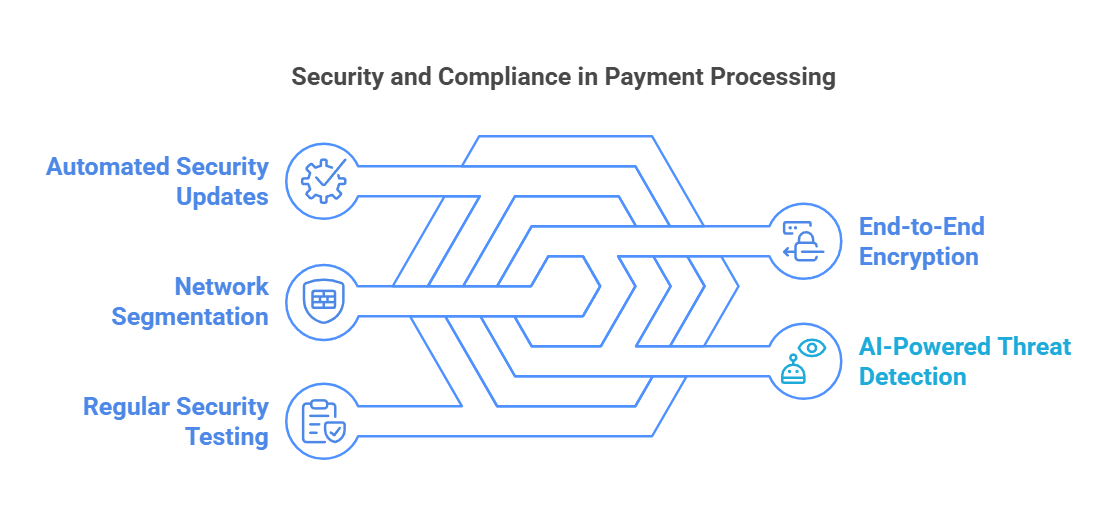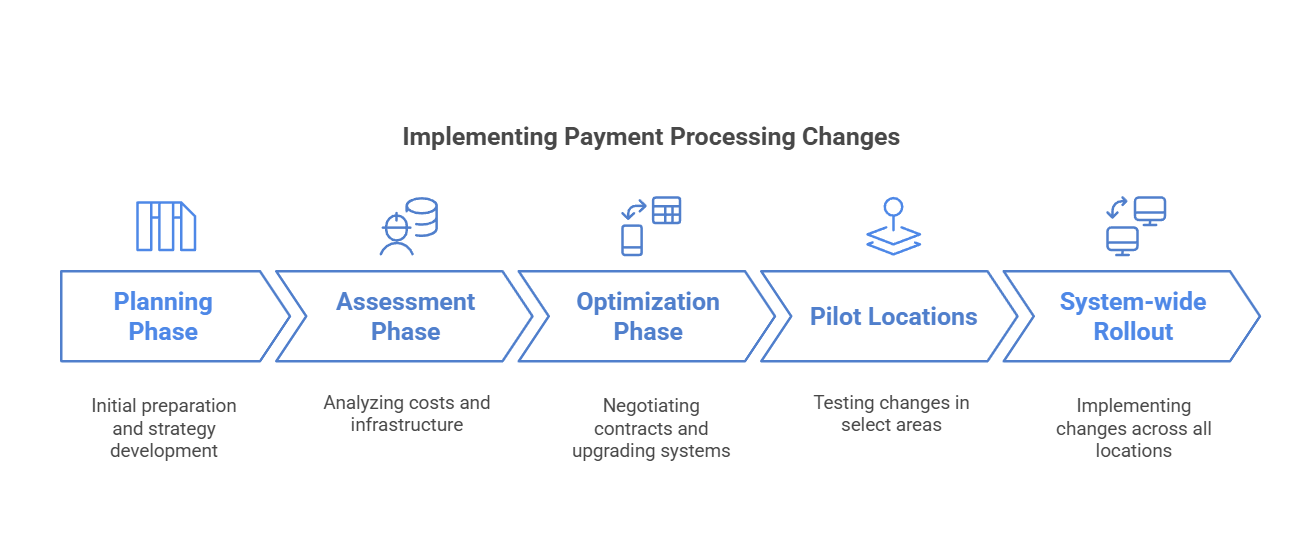
Pizza POS Payment Processing: Maximizing Efficiency While Minimizing Fees
Article at a Glance:
- Modern payment processing for pizza chains requires orchestrating multiple channels, from traditional card payments to digital wallets, mobile apps, and third-party delivery platforms, all while maintaining seamless integration and security.
- Understanding and optimizing processing fees can significantly impact profitability, with strategies ranging from volume-based negotiations to smart payment account structuring that can save chains tens of thousands annually.
- Technical infrastructure and security measures are critical, requiring redundant systems, advanced encryption, and comprehensive monitoring tools to prevent costly downtime and protect customer data.
- Creating a unified payment experience across all channels demands careful selection of POS systems with high reliability, automated failover capabilities, and robust integration options.
- Implementation and ongoing optimization require careful planning, from initial assessment through system-wide rollout, with continuous monitoring of key metrics for success.
For large pizza chains processing thousands of daily transactions, payment processing efficiency isn’t just about moving money – it’s a critical business function that directly impacts customer satisfaction, operational costs, and overall profitability. This guide provides a comprehensive roadmap for optimizing payment processing systems across multiple locations.
The world of payment processing for large pizza chains is a lot like orchestrating a symphony – when everything’s in harmony, it’s beautiful, but one wrong note can throw off the entire performance. Today’s pizza chains are juggling thousands of daily transactions across multiple locations, making POS for pizza operations not just a backend operation, but a critical lifeline that can make or break their profitability.
Gone are the simple days of cash registers and credit card imprinters. The modern payment landscape has transformed into a complex ecosystem where traditional cash transactions dance alongside digital wallets, mobile payments, and cryptocurrency. For chain operators, this evolution brings both exciting opportunities and head-scratching challenges.
The Modern Payment Ecosystem: More Than Just Swiping Cards

The digital revolution has fundamentally changed how customers interact with pizza chains. While traditional payment methods haven’t disappeared, they’ve been joined by a host of digital alternatives that customers increasingly prefer. This transformation requires a delicate balance – maintaining the reliability of conventional payment methods while embracing digital innovations that enhance both customer experience and operational efficiency.
Key digital channels that modern pizza chains must master include:
- Mobile app transactions that demand seamless POS for pizza integration while keeping customer data fortress-secure
- Online ordering platforms that need to handle sudden surges during major sporting events or holidays
- Third-party delivery service integrations requiring sophisticated reconciliation processes
- Digital wallet solutions that add convenience but demand enhanced security protocols
Traditional channels, though less flashy, remain crucial:
- In-store terminal transactions requiring bullet-proof backup systems
- Phone orders needing secure payment capture protocols
- Drive-through services demanding lightning-fast processing
- Catering operations requiring specialized payment handling for corporate accounts
Understanding the Fee Maze: Not All Costs Are Created Equal
The world of payment processing fees can feel like navigating a labyrinth blindfolded. While many chain operators see their processing statement as a mysterious black box of charges, understanding its components is crucial for effective cost management.
Think of payment processing fees as a three-layer cake. The bottom layer – interchange fees – forms the foundation and typically gobbles up 70-80% of your total processing costs. These fees are set in stone by card networks and banks, making them as negotiable as gravity. The middle layer consists of assessment fees, while the top layer represents processor markups – these upper layers offer some room for negotiation, especially for high-volume operations.
Several factors influence your rates, much like ingredients affect a pizza’s final cost:
- Card-present transactions generally earn better rates than online orders
- Premium rewards cards often carry higher processing fees
- Commercial card transactions can qualify for better rates with proper data submission
- International cards may incur additional cross-border fees
Strategic Cost Optimization: Making Your Volume Work for You

Just as buying ingredients in bulk can reduce your food costs, processing high transaction volumes can lead to significant savings on payment processing. While you can’t negotiate with card networks about interchange fees, you can leverage your volume to secure better deals on processor markups and additional services.
The art of negotiation in payment processing requires understanding both your leverage and the processor’s flexibility. Large chains processing millions in monthly transactions often hold more cards at the bargaining table than they realize. Picture yourself at a high-stakes poker game – knowing when to push for better terms and when to hold steady can make a difference of tens of thousands in annual processing costs.
Key elements to consider in your negotiation strategy:
- Multi-year commitments that can unlock preferential pricing tiers
- Volume-based scaling that automatically reduces rates as your business grows
- Equipment and software bundling across locations
- Participation in card network optimization programs
Payment Account Structure: Finding Your Perfect Fit
Choosing between payment facilitators and direct merchant accounts is like deciding between buying or leasing a car – each option has its place, but high-volume operations typically benefit more from ownership. While payment facilitators offer plug-and-play simplicity, direct merchant accounts usually provide substantial cost advantages for large chains.
The impact of this choice ripples through your entire operation:
- Processing costs often drop significantly with direct merchant accounts
- Risk management becomes more nuanced but offers greater control
- Settlement timeframes become more flexible
- Reporting capabilities expand dramatically
Building Your Technical Fortress
Your payment processing infrastructure needs to be as reliable as your pizza recipe. With modern pizza point of sale systems, even a few minutes of downtime can cost thousands in lost sales and frustrated customers. Think of your technical infrastructure as a well-designed kitchen – every component must work seamlessly together while maintaining the highest standards of safety and efficiency.
Essential elements of a robust payment processing kitchen include:
- Redundant internet connections that automatically switch if one fails
- Load-balanced payment gateways distributed across multiple data centers
- Offline processing capabilities for those “just in case” moments
- High-speed processing solutions that complete transactions faster than you can say “extra cheese”
Security and Compliance: Your Digital Health Inspector

In the restaurant world, health inspections ensure food safety. In payment processing, security and compliance serve the same crucial role. A security breach can be more damaging than a bad Yelp review, potentially eroding years of carefully built customer trust.
Network segmentation plays a starring role in your security strategy, much like keeping raw ingredients separate from cooked foods. This separation creates distinct security zones that prevent potential breaches from spreading throughout your system.
Critical security ingredients include:
- End-to-end encryption for all payment data
- Real-time monitoring systems with AI-powered threat detection
- Automated security updates across all locations
- Regular security testing by certified third-party providers
Creating a Unified Payment Experience
Imagine trying to run a pizzeria where every cook follows a different recipe for the same dish. Chaos, right? The same principle applies to payment processing across multiple channels. Creating a unified payment ecosystem requires careful orchestration of different channels while maintaining consistency and efficiency.
Your POS for pizza selection becomes the foundation of this unified experience, much like your pizza dough recipe forms the base of every pie. When evaluating systems, look for providers offering rock-solid reliability with uptime guarantees of 99.99% or higher. The technical architecture should handle everything from peak Friday night rushes to slow Tuesday afternoons without breaking a sweat.
Essential ingredients for a successful multi-channel strategy include:
- Automated failover systems that keep transactions flowing even when problems arise
- Comprehensive monitoring tools that alert you before small issues become big problems
- Advanced reporting capabilities that help you spot trends and opportunities
- Developer-friendly APIs that play nice with your existing systems
- Built-in support for loyalty programs and customer data management
Implementation: The Recipe for Success

Rolling out payment processing changes across a large chain requires the same careful planning as opening a new location. You wouldn’t open a restaurant without proper preparation, and you shouldn’t overhaul your POS for pizza without a detailed roadmap.
The journey typically unfolds in two major phases: Assessment Phase (3-6 months): Think of this as your research and development period. You’ll analyze current costs, evaluate your technical infrastructure, and identify areas for improvement. This phase sets the foundation for everything that follows.
Optimization Phase (6-12 months): This is where the rubber meets the road. You’ll negotiate contracts, upgrade systems, enhance security, and train staff. Like perfecting a new pizza recipe, you’ll start with pilot locations before rolling changes out system-wide.
Mastering Authorization and Validation
Payment authorization optimization is like perfecting your delivery timing – every second counts, but accuracy can’t be sacrificed for speed. A comprehensive approach to data validation helps prevent fraud while maximizing approval rates.
Smart authorization strategies weave together multiple elements:
- Real-time routing that sends transactions through optimal processing paths
- Intelligent retry logic for handling temporary declines
- Automated card information updates that prevent unnecessary declines
- Machine learning systems that spot potential fraud faster than human eyes
- Custom rules based on your chain’s unique transaction patterns
Managing the Hidden Costs
Just as running a successful pizzeria involves more than just ingredients and labor, payment processing costs extend beyond basic transaction fees. Integration and maintenance typically gobble up 15-20% of total processing expenses – a significant slice of your payment processing pie.
These behind-the-scenes costs often catch operators off guard, much like unexpected equipment repairs in the kitchen. They include everything from system integration development to ongoing maintenance, staff training, security compliance, and the impact of system downtime. Think of these as the overhead costs of your payment processing kitchen – necessary investments for smooth operations.
Measuring Success: Your Payment Processing Report Card
You wouldn’t run your pizzeria without tracking food costs and customer satisfaction. Similarly, your payment processing system needs regular performance monitoring. Keep a close eye on metrics like authorization rates, processing costs as a percentage of revenue, transaction processing times, and chargeback rates. These numbers tell the story of your system’s health and efficiency.
Planning for the Unexpected
Even the best-run kitchens occasionally face emergencies, and payment processing is no different. Your business continuity plan should be as well-thought-out as your disaster recovery procedures for your physical locations. Consider every possible disruption scenario and have clear, tested procedures for handling them.
Frequently Asked Questions (FAQ)
Q: What’s the secret sauce for optimizing interchange rates?
A: While base rates aren’t negotiable, you can improve your overall costs by submitting detailed transaction data, implementing strong fraud prevention, and keeping your systems updated. Think of it as following a recipe precisely to get the best results.
Q: How can we boost our authorization rates?
A: Success comes from a combination of clean data, smart retry logic, and regular system maintenance. Like maintaining kitchen equipment, regular attention to these details keeps everything running smoothly.
Frequently Unasked Questions (FUQ)
Q: How does payment processing affect customer loyalty?
A: Just as a consistently great pizza keeps customers coming back, smooth payment experiences build loyalty. Research shows that payment hiccups can send customers straight to competitors, regardless of how good your product is.
Q: What about environmental considerations?
A: Your payment processing choices can impact your environmental footprint through energy usage and hardware lifecycle management. Consider options like digital receipts and energy-efficient processing systems to reduce your impact.
Streamline Your Pizzeria’s Operations with Adora POS
In the fast-paced restaurant industry, efficiency and precision are essential. Adora POS is a powerful, cloud-based solution designed specifically for pizzerias, offering faster order processing, improved accuracy, and seamless inventory management. With fully integrated online ordering, call center capabilities, and 24/7 personalized support, Adora POS empowers you to run your business with confidence and ease.
Experience the difference with Adora POS. Request a personalized demo today and discover how our advanced technology can optimize your restaurant’s operations.
Stay connected for industry insights and updates:



